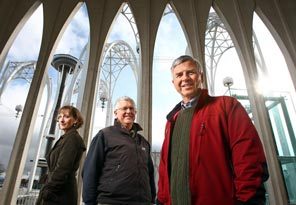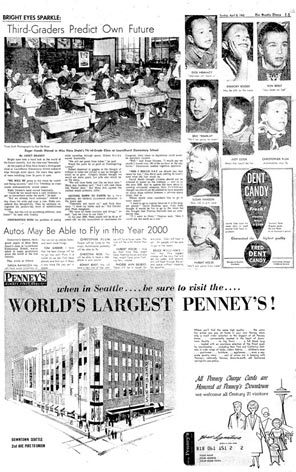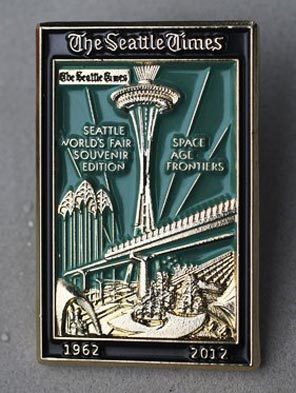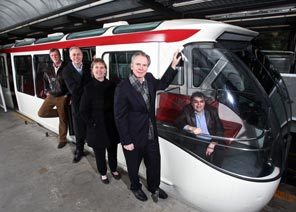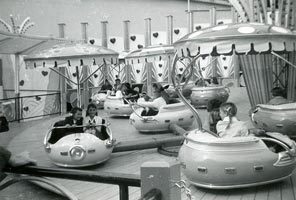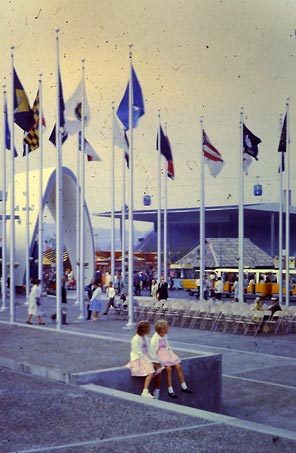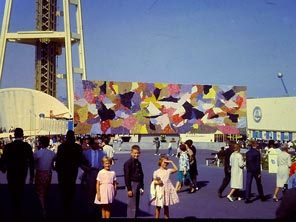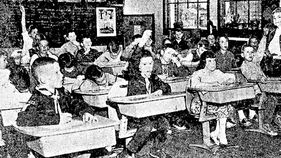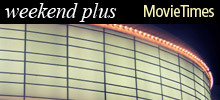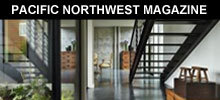Originally published April 14, 2012 at 8:04 PM | Page modified April 17, 2012 at 2:34 PM
1962 classmates did a fair job of predicting 21st-century life
In the days leading up to the opening of the 1962 Seattle World's Fair, third-graders at Seattle's Laurelhurst Elementary School made predictions about the 21st century. Now in their late 50s, members of the class look back on those predictions.
Seattle Times staff reporter
JOHN LOK / THE SEATTLE TIMES
Former Laurelhurst Elementary School classmates Chris Rich, left, Tom Greene, center, and Bruce Williams were among eight from their third-grade class who reunited at Seattle Center recently to revisit their childhood predictions and to make some more.
RON DE ROSA / THE SEATTLE TIMES
A copy of the article reporting what Miss Nora Strate's third-grade class thought life would be like in the 21st century.
JOHN LOK / THE SEATTLE TIMES
Former classmates, left to right, Webb Nelson, Bert Kolde, Phoebe Russell, Tom Norwalk and David Shulman stop at the monorail at their recent reunion.
COURTESY CHRIS RICH
Chris Rich, who is sitting on the right in the car facing the camera, remembers the thrill of the fair and its many rides.
1962 SPECIAL SECTION
When the world came to Seattle

On April 21, 1962, the gates opened to a World's Fair in Seattle that left an indelible stamp on the city's image and future.
For 184 days, locals and visitors alike marveled at the Space Needle, the Monorail, the "World of Tomorrow" pavilions, and the "Spacearium."
Days before the opening, The Seattle Times published a 152-page "Seattle World's Fair Souvenir Edition" that was packed with information about the fair as well as predictions for the future. We're celebrating the anniversary by revisiting that section:
![]()
You have to hand it to Christina Rich.
A half-century ago, just before the 1962 Seattle World's Fair, a reporter from The Seattle Times visited Laurelhurst Elementary School to ask third-graders what life would be like in the 21st century.
Everyone will have their own rocket, said Phoebe Ann Gilbert. Cars will fly, said Bruce Williams.
But a tall, shy Bluebird in the back of the class had an idea much more down-to-earth.
"You will be able to have a telephone in your pocket," said Christina Rich, then a few months short of her 9th birthday, foreseeing an invention that would become a defining aspect of modern life.
Today at 58, Chris Rich can't remember what got her thinking about pocket-size phones.
She has one, of course, and uses it daily — more for email than conversation — as vice president and chief financial officer of Green Diamond Resource, a forest-products company.
She has a clearer recollection of the event that prompted virtually all of Seattle to focus on the future in April 1962: The Century 21 Exposition, which was about to open a six-month run putting Seattle on a world stage.
Next Saturday, a full slate of activities at Seattle Center will mark the anniversary of the fair's opening.
Rich still has a clipping of the half-page Seattle Times article about her Laurelhurst class, which ran under the headlines, "Third-Graders Predict Own Future" and "Autos May Be Able to Fly in the Year 2000."
She brought the brittle, yellowed copy from her mom's scrapbook to Seattle Center, where The Times recently invited her and some classmates to revisit their memories of the fair, to see whether the future has measured up to their expectations — and to make predictions about the world that will exist 50 years from now.
Of the 29 members of the third-grade class, 18 were named in the 1962 Times article. Of those, eight gathered at Seattle Center and two were interviewed by phone.
Results on the students' predictions from 1962 are mixed. Several students had envisioned flying cars, and why not? They were a popular fantasy in the mid-20th century and a basic amenity on "The Jetsons," the futuristic, animated TV sitcom that debuted the same year as the Seattle World's Fair.
Bruce Williams, who would grow up to become chief executive officer of HomeStreet Bank, imagined cars that would "float through the air and space without stopping for gasoline."
You can find flying cars these days — experimental ones and prototypes, mostly — on the Web.
But they aren't in our driveways and garages, or coasting smoothly above road-bound traffic. Today's cars may be safer, smarter and cleaner than the ones of the 1960s, but they work pretty much the same way — and having to gas them up is still a painful reality.
Third-grader Teresa Rayacich, who now lives in Oakland, Calif., didn't use the term "Internet" but was on the mark when she said the 21st century would bring "more inventions so that we can go places faster and learn more things."
High-achieving adults
A striking aspect of Miss Nora Strate's 1962 third-grade students is how accomplished they've become, in a wide array of fields.
In addition to the former bank boss (Williams) and timber-company exec (Rich), the group includes entrepreneurs who created a film school, toy company and fruit-products wholesaler. There's an author in the mix, along with the head of Seattle's Convention and Visitors Bureau, a soccer-league administrator and a top adviser to Microsoft co-founder Paul Allen.
Laurelhurst's affluence undoubtedly figured in their success. For the most part, these students would have come from homes where achievement was not just facilitated, but expected.
Bert Kolde, the Allen associate, said Seattle Public Schools deserve some credit. He and most of his classmates went from Laurelhurst Elementary to Eckstein Junior High School and then Roosevelt High School, graduating in 1971. "I had some good teachers in all three schools and overall a good learning experience."
Kolde met Allen at Washington State University, where the two were roommates. Kolde is senior director of Vulcan, and serves on the boards of Allen's teams, the Seattle Seahawks and Portland Trail Blazers.
As a third-grader, Kolde told Times reporter Janet Brandt that space travelers would eat paste from tubes, but the article says he "dissolved in giggles" at the suggestion of eating Thanksgiving turkey from a tube.
One of the first students quoted in the 1962 story was Webb Nelson. His prediction: a superfast transportation method traveling under Earth's surface.
Like a subway? another student asked. Yes, said Nelson — but faster.
As an adult, Nelson, of Seattle, co-founded the novelty toy company Play Visions, which offers everything from Darth Vader key-ring lights to an iPhone application that teaches yodeling.
Tom Greene, another third-grader, let his imagination soar. "The best change," he said, "will be to go way past Pluto in a rocket so we can find more planets and find out if there is any more life way out in space."
Greene, of Bainbridge Island, co-founded Interpack Northwest Frozen Foods, wholesalers of frozen fruit, purée and juice concentrates.
And Phoebe Gilbert (now Phoebe Russell of West Seattle), who envisioned personalized rockets, does soccer scheduling and referee registration for local and state soccer associations.
Russell says the third-grader inside her is disappointed that ordinary people aren't going back and forth to the moon. But as an adult, she realizes other priorities have intervened.
She's still transportation-minded when looking to the future, with a prediction that by 2062, we'll have "government-supplied, accident-proof, sustainable nano-tech-fueled vehicles for all."
Travel-minded
In 1962, space travel was also on the mind of Tom Norwalk, who said if he flew to Pluto, Earth would look like a star.
These days, it's Norwalk's job to get travelers to come to Seattle — not from other planets, but from all over this one. As president and CEO of Seattle's Convention and Visitors Bureau, he was in Japan when baseball season opened, talking up Seattle to 100 Japanese tourism executives.
The Seattle he foresees in 50 years will be in the five top U.S. visitor destinations (it's now about 10th) and will be back in the NBA, something sports fans undoubtedly hope won't take a half-century.
While some of her third-grade classmates speculated about futuristic food in the 21st century, Mary Jacobson knew what she wanted: home cooking.
"We will have foods just like we have now," she told the reporter. "And I will cook them like Mother does."
Jacobson proves herself right every time she makes chutney, simmering it all day, as she learned from her mother, who died of Parkinson's disease in 2009. Jacobson wrote about caring for her mother in the book, "One in a Million," published in 2010.
Within a year of her mother's death, Jacobson was diagnosed with Parkinson's. Her thoughts of the future start with the hope that a cure will be found for the disease.
David Shulman, who as a third-grader speculated about going to Jupiter, sees ominous signs ahead. The founder and executive director of Seattle Film Institute predicts global warming and rising sea levels, and power in the U.S. in 2062 consolidated "under a near-totalitarian government."
Meanwhile, when Chris Rich thinks of the future, she sees a cashless society in which money is digitally stored and transmitted on "an all-purpose device," along with encrypted medical records and other personal information.
She's not sure what the device will look like, but she does know this: It will fit in your pocket.
Seattle Times news researcher Miyoko Wolf contributed to this report. Jack Broom: 206-464-2222 or jbroom@seattletimes.com







